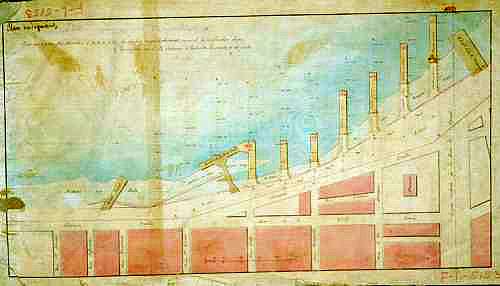

Plan of sounding lines off the levee of the First Municipality, ca. 1838. In addition to showing the location of early wharves on the Vieux Carre riverfront, the plan also points out the site of the City's original Custom House (Douane).The plan displayed here shows the wharves along the Vieux Carre riverfront approximately eight years before the scene described by Norman, at a time when the levee was something more than "a pleasant promenade" but had not yet reached its full commercial potential. During the 1840s and 1850s the number and size of wharves grew dramatically. Most of the work to expand the New Orleans port facilities was supervised by the City Surveyor and much of the construction of wharves was financed by the municipal government. As the cost of building and maintaining the port grew, however, the city began to lease wharves out to private companies who took on the responsibility for their repair. That process began in the last years before the Civil War and became standard procedure during Reconstruction. In 1896 the State of Louisiana took control of the harbor and put it into the hands of the newly created Board of Commissioners for the Port of New Orleans--the "Dock Board."[City Surveyor's Office Records]
In 1903, the Dock Board noted in its annual report:
The public wharf system of the port of New Orleans, at the present time consists of an almost continuous wharf line from Louisiana Avenue to Clouet Street, a distance of practically four miles; of this system the Board of Commissioners of the Port of New Orleans, since the expiration of the wharf lease on the 29th of May, 1901, at which time possession was taken of the revenues of the wharves and the assumption of maintaining the system, have reconstructed the Clouet street wharf, the Picayune Tier wharf, the Julia street wharf, the Henderson street wharf, the Market street wharf, the Orange street wharf, the Egania street wharf, and a wharf from Louisiana avenue to Toledano street, and when it is considered that the balance of the system constructed by the lessees was constructed with a view of earning to the company the largest dividends possible, and the age of the wharves now standing of this system received from the lessees to be such as to require renewal of the balance of the entire system, comprising the wharves from Toledano to Jackson street, from Jackson to Market street, almost the entire steamboat wharves from Lafayette to Conti street, the steamship wharf from Conti street to the Picayune Tier wharf, the wharf from Hospital to Barracks street, and the wharf from Marigny street to St. Ferdinand street. It will be seen that there is a great work before the board; nor is the reconstruction of the wharf system all that is to be done, sheds should and must be constructed over the entire length of wharves and over the batture where practicable, not only as a matter of economy to the commerce of the port as is shown by statement of shed charges at the Henderson street wharf, compared to former charges of tarpaulin hire, but for the more paramount reason of humanity. Permanent roadways must also be constructed on the river front and the approaches thereto, for this entire distance.It is easy to imagine the New Orleans City Engineer, successor to the old office of City Surveyor, breathing a sigh of relief on reading this passage. No longer was it his responsibility to oversee such a vast construction project!
 Back to River Exhibit Main Page
Back to River Exhibit Main Page
iw/we 5/1998